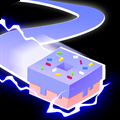Clash Of Clans Builder Base Spring Trap Guide - Theria Games

Introduction to Clash of Clans Builder Base Spring Trap Guide
The Spring Trap is a defensive mechanism designed to instantly remove ground troops from battle by launching them off the map. Unlike other traps that deal damage, the Spring Trap eliminates units entirely, making it a valuable tool for countering specific melee attackers in the Builder Base of Clash of Clans.
LevelSpring CapacityCostBuild TimeExperience GainedBuilder Hall Level Required1410,000N/AN/A32630,0001h60437100,0001d293648300,0002d4158Trigger Radius: 0.7 tiles
Damage Type: Bounces away troops
Unit Type Targeted: Ground
Favorite Target: None
Key Features:
The Spring Trap is one of the most effective defensive traps in the Builder Base, instantly removing ground troops that exceed its weight capacity. Unlike damage-based traps, the Spring Trap does not deal hitpoint damage but instead eliminates affected units from the battlefield entirely. This makes it a powerful tool against swarms of melee troops and mid-weight units like Boxer Giants and Cannon Carts.
One of the advantages of the Spring Trap in the Builder Base is that it does not need to be re-armed after activation. Once triggered, it remains functional for the next attack, ensuring consistent defensive value without requiring manual resets. When troops are flung off the battlefield, it is visually apparent, making it easy to assess its effectiveness during replays.
Best Uses in Defense:
To maximize its impact, placing Spring Traps near Crushers is a strong defensive strategy. Crushers deal devastating splash damage to ground troops, but they can be overwhelmed if too many units reach them at once. A Spring Trap positioned in front of a Crusher removes some attackers before they get close, reducing the risk of the defense being overrun.
Spring Traps are also effective when placed near key defenses like the Roaster or X-Bow. These structures rely on sustained firepower to eliminate enemy troops, but tanky units like Boxer Giants or Power P.E.K.K.A can absorb too many hits. By removing some of these front-line units before they reach the defenses, Spring Traps help extend the lifespan of crucial defensive structures.
Another strategic placement is at entry points where attackers typically deploy their first wave of troops. Many players send in Boxer Giants or Raged Barbarians to absorb damage before deploying their damage-dealing troops. Placing Spring Traps at these choke points can immediately weaken their attack, forcing them to spend more troops than planned.
For even greater effectiveness, Spring Traps can be paired with Push Traps. A Push Trap can launch enemy units directly onto a Spring Trap, ensuring that those troops are instantly removed from battle. This setup is particularly useful for countering Cannon Carts or Night Witches, as it disrupts their attack pattern while also eliminating key units.
Limitations:
However, Spring Traps do have limitations. Each trap has a weight capacity, meaning that heavier troops like the Power P.E.K.K.A or Battle Machine are immune. These units will not be removed by the trap, so other defenses must be relied upon to counter them. Additionally, Spring Traps only affect ground units, meaning air troops like Beta Minions and Drop Ships are completely unaffected.
By strategically placing Spring Traps in key locations, defenders can significantly weaken an attacker’s army and disrupt their strategy.
Requirements
Spring Traps can be placed in the Builder Base without requiring the Master Builder or O.T.T.O., making them an accessible defensive option early on. However, upgrading them does require either the Master Builder or O.T.T.O., meaning players must manage their builder availability carefully when planning trap upgrades.
Upgrading Spring Traps increases their spring capacity, allowing them to remove heavier units or multiple lighter troops at once. This makes them more effective against tanky frontline units like Boxer Giants, which can otherwise absorb a lot of damage. Since higher-level Spring Traps can eliminate more troops per activation, investing in upgrades can significantly enhance base defense over time.
Because the Master Builder or O.T.T.O. is also required for upgrading other important buildings and defenses, prioritizing Spring Trap upgrades depends on a player’s overall defensive strategy. If opponents frequently use swarms of ground units, upgrading Spring Traps can provide a strong countermeasure. However, if air attacks are more common, investing in air-targeting defenses may be a better use of builder time.
Managing builder time efficiently is key to maintaining a well-upgraded Builder Base, ensuring that both traps and defensive structures improve at a balanced rate.
Spring Capacity
Spring Traps in the Builder Base have a specific spring capacity, determining how many troops they can remove from battle upon activation. Each troop has a spring weight, and if the combined weight of troops standing on the trap is within its capacity, they will be flung off the battlefield instantly.
Upgrading Spring Traps increases their capacity, allowing them to eliminate more troops at once. Lighter troops like Skeletons (spring weight of 1), Sneaky Archers (spring weight of 3), and Raged Barbarians (spring weight of 4) are particularly vulnerable to Spring Traps, as they require only a small amount of capacity to be removed. A higher-level Spring Trap can take out multiple of these units at the same time.
Most other ground troops, such as Boxer Giants, Power P.E.K.K.As, and Battle Machines, have a spring weight that exceeds the capacity of Spring Traps, making them immune. These tanky units are designed to absorb damage and push through defenses, meaning Spring Traps are best used against lighter, more numerous ground troops.
Strategic placement of Spring Traps in areas where swarms of small ground units typically pass through can maximize their effectiveness. Pairing them with Push Traps can also ensure that lighter troops land directly onto a Spring Trap, eliminating them before they can deal damage.
Defensive Strategies
Spring Traps can be used in combination with Push Traps to maximize their effectiveness. By positioning a Push Trap to launch troops directly onto a Spring Trap, defenders can efficiently remove distraction troops before they become a problem. This strategy is particularly useful against swarm units like Raged Barbarians and Sneaky Archers, which attackers often deploy in groups to overwhelm defenses.
One common tactic is placing Spring Traps in one-by-one tile gaps leading to high-damage defenses like Crushers. When ground troops attempt to pass through, they get flung off the battlefield before they can even engage with the defense, preventing them from dealing any damage. This is especially useful in funneling troops into kill zones where other defenses can take them out more efficiently.
Attackers may try to trigger Spring Traps using cheap troops like Raged Barbarians, sacrificing a few units to clear the traps before sending in more valuable troops. However, placing Spring Traps in unexpected locations or within key attack paths can still catch opponents off guard.
Since Sneaky Archers rely on their invisibility to deal damage safely, placing Spring Traps in areas where they commonly attack from can be an effective counter. If they are within the trap’s capacity, they will be instantly removed before they can destroy critical defenses, forcing the attacker to adjust their strategy.
Offensive Strategies
Using expendable units like Raged Barbarians to trigger Spring Traps is a common tactic among attackers. Since these traps instantly remove affected troops from battle, sacrificing a few low-value units can help clear the way for stronger troops. Deploying a couple of Raged Barbarians ahead of key units like Boxer Giants or Cannon Carts ensures that Spring Traps are triggered early, preventing them from eliminating more valuable troops later in the attack.
Predicting the location of hidden Spring Traps is also an important skill for attackers. Experienced players often analyze base layouts to identify common trap placements, such as choke points, narrow pathways, or areas near Crushers and other key defenses. By carefully deploying troops and watching for signs of traps, attackers can minimize the impact of Spring Traps and maintain a stronger offensive push.
Upgrade Differences
The Spring Trap undergoes noticeable visual upgrades as it is leveled up, making it easier to distinguish higher-level traps.
At level 1, the Spring Trap consists of a simple wooden board attached to a metal spring. This basic design effectively flings ground troops off the battlefield when triggered.
At level 2 and 3, the trap receives a thicker spring and a wider wooden board, making it more robust. This upgrade signifies an increase in its spring capacity, allowing it to remove heavier troops from battle.
By level 4, the Spring Trap takes on a more reinforced appearance. A metal border is added around the edges of the wooden board, giving it a sturdier, more durable look. This design closely resembles the level 5 Spring Trap found in the Home Village, making it clear that the trap has reached its highest form in the Builder Base.
Upgrade Facts
Traps in the Builder Base have multiple upgrade levels, improving their effectiveness as they are leveled up.
Purchasing a trap does not require the Master Builder, but upgrading it does. This means players can place traps early but will need the Master Builder to enhance their strength over time.
Compared to defensive buildings, trap upgrades have relatively short upgrade times, allowing for quicker improvements. However, each trap must be upgraded individually, meaning players need to plan upgrades carefully to maximize defensive efficiency.
Once a trap is upgraded, its level is permanent, and it retains its effectiveness even after activation. Unlike some defenses that require re-arming, traps in the Builder Base remain at their upgraded level without needing resets.
Traps that are currently being upgraded are visible to attackers, which can expose weaknesses in the base. To prevent this from being exploited, it is a good practice to relocate traps undergoing upgrades to minimize their impact on base defense until they are fully upgraded.
Trap Synergies
Spring Traps are most effective when combined with other defensive mechanisms that complement their ability to remove ground troops. While they don’t deal damage directly, they can be strategically placed to maximize the impact of other defenses.
One effective combination is using Spring Traps with Push Traps. By directing enemy units onto a Spring Trap, the Push Trap ensures that troops are instantly removed before they can cause damage. This is particularly useful for stopping tanky units like Boxer Giants from absorbing hits while protecting key defenses like Roasters or Double Cannons.
Another strong synergy is Spring Traps with Crushers. Crushers deal massive splash damage but have a slow attack speed, making them vulnerable to being overwhelmed. Placing a Spring Trap just in front of a Crusher can remove some frontline troops before they reach the Crusher, allowing it to deliver more devastating blows to the remaining troops.
For defending against swarms, Spring Traps and Mega Mines work well together. The Mega Mine deals heavy area damage, but if too many units reach it at once, some might survive. A Spring Trap placed nearby ensures that some troops are eliminated instantly, reducing the overall threat level.
Spring Traps also complement Roasters and X-Bows, as these defenses rely on sustained firepower to clear enemy troops. Removing tanky melee units like Boxer Giants or Hog Gliders before they reach these defenses allows them to focus on ranged attackers like Cannon Carts and Night Witches without being quickly destroyed.
Common Mistakes to Avoid
While Spring Traps are powerful, incorrect placement can significantly reduce their effectiveness. Here are some common mistakes to avoid when using them:
Placing them too far from key defenses:
One common mistake is placing Spring Traps too far from key defenses. If positioned randomly, they may end up triggering on low-value troops like Sneaky Archers instead of removing major threats like Boxer Giants or Cannon Carts. To maximize their impact, they should be placed near essential defenses such as Crushers, Roasters, or X-Bows.
Not pairing them with other defenses:
Another mistake is relying solely on Spring Traps without pairing them with other defenses. Spring Traps work best when combined with Crushers, Push Traps, or Mega Mines, ensuring they contribute to a larger defensive strategy rather than acting as isolated obstacles.
Making trap locations too predictable:
Predictability is also a problem. Experienced attackers often study base layouts and expect Spring Traps in common choke points. If traps are placed in obvious spots, attackers can trigger them with expendable units like Raged Barbarians before deploying their main force. To counter this, trap placements should be varied, with some positioned in unexpected areas to surprise opponents.
Forgetting to upgrade Spring Traps:
Forgetting to upgrade Spring Traps is another major issue. Higher-level traps have greater spring capacity, allowing them to remove more troops or even heavier units. Neglecting upgrades makes them far less effective against well-planned attacks, reducing their ability to thin out enemy forces.
Ignoring air attacks:
Finally, it’s important to consider air threats. Since Spring Traps only affect ground units, bases that struggle against Beta Minions or Drop Ships should focus on upgrading air-targeting defenses first. Balancing both ground and air defense ensures a more well-rounded and effective base layout.
Advanced Tactics for Pro Players
High-level players use Spring Traps not just for defense but also to manipulate enemy troop movements. Some advanced strategies include:
Spring Traps can be used strategically to disrupt enemy attacks, forcing opponents to waste troops and making their assault less effective. Proper placement and clever base design can maximize their impact.
One effective strategy is baiting attacks with false openings. Placing Spring Traps in areas that appear to be weak entry points can trick attackers into deploying their troops there, only to have them instantly flung off the battlefield. This weakens their assault before it even begins.
Another approach is guiding enemy troops into kill zones. By designing the base with narrow pathways that lead to key defenses like Crushers, Spring Traps can ensure that attacking forces are funneled into heavily defended areas where they are quickly eliminated.
Layering multiple traps in sequence further increases defensive efficiency. A well-placed Push Trap can launch units onto a Spring Trap, which then removes them from battle. If combined with a Mega Mine, entire groups of troops can be wiped out before they even reach important structures.
Some players also use decoy Spring Traps to mislead attackers. By placing “dummy” traps in predictable locations while hiding the real ones in unexpected spots, attackers may waste troops clearing fake traps, only to be caught off guard by the actual ones. This psychological tactic forces opponents to second-guess their deployment, slowing down their attack and increasing the likelihood of a failed raid.
Impact on Various Attack Strategies
Different attacking strategies are affected by Spring Traps in unique ways. Understanding these interactions helps defenders counter popular attack styles more effectively.
Mass Raged Barbarians:
This strategy relies on overwhelming defenses with fast, numerous troops. Spring Traps counter this by instantly removing multiple Raged Barbarians at once, disrupting their swarm effect. Placing traps near Crushers or behind walls can force attackers to lose a portion of their army before they reach key defenses.
Cannon Cart pushes:
Cannon Carts deal high damage from range but rely on tanky units like Boxer Giants to absorb damage. A well-placed Spring Trap can remove some of these tanks, leaving the Cannon Carts exposed and vulnerable to defenses like X-Bows or Roasters.
Sneaky Archers and Night Witches:
These troops attack from range and rely on staying alive long enough to deal sustained damage. While Spring Traps do not target air troops, they can be used to eliminate ground-based support troops, like Boxer Giants, that protect Night Witches. This forces Night Witches to be more vulnerable to air-targeting defenses.
Boxer Giant tanking strategies:
Since Boxer Giants absorb a lot of damage, attackers depend on them to clear paths for stronger units. A Spring Trap placed in their path weakens the attack by removing some of these frontline troops before they reach their target.
By considering how Spring Traps affect different attack styles, defenders can optimize their base layouts to counter the most common threats.













